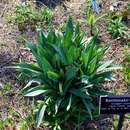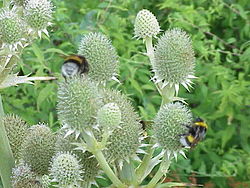pt-BR
nomes no trilho de navegação



Eryngium yuccifolium ( lat. Eryngium yuccifolium L. ) është bimë dhe klasifikohet në familjen e bimëve Apiaceae .
Eryngium yuccifolium ( lat. Eryngium yuccifolium L. ) është bimë dhe klasifikohet në familjen e bimëve Apiaceae .





Eryngium yuccifolium, known as rattlesnake master, button eryngo, and button snake-root, is a perennial herb of the parsley family native to the tallgrass prairies of central and eastern North America. It grows from Minnesota east to Ohio and south to Texas and Florida, including a few spots in Connecticut, New Jersey, Maryland, and Delaware.
The common name "rattlesnake master" is attributed to early European pioneers erroneously believing the plant to be an antidote for rattlesnake venom based upon Native Americans' various medicinal uses of the plant.[3] The species name yuccifolium "yucca-leaved" was given because its leaves resemble those of yuccas.[3]
The leaves are stiff, long and narrow with a sharp tip, 15–100 cm (0–5 ft) long but only 1–3 cm (0.39–1.18 in) broad. They are bluish-green, and covered in a waxy coating. On the edges are regularly spaced bristles or spines. The root system consists of a central taproot surrounded by thick fleshy fibrous roots.[4]
It grows up to 1.8 m (5.9 ft) tall, with 10–40 dense, ball-shaped umbels of flowers produced at the top of each stem.[5] Each of these condensed umbels is 1–3 cm (0.5–1 in) in diameter, resembling flowerheads. Individual flowers in the umbels are small, 3–4 mm in diameter, with greenish-white or bluish-white petals and a faint honey-like scent. Underneath each flower is a spiny green bract, and underneath each flower cluster is a small star-like rosette of spiny bracts. The flowers are produced in July and August.[4][6]
After the flowerbuds open, the pollen matures and is released two to three days before the stigmas become receptive.[5] This encourages cross-pollination by making it unlikely that a given flower's pollen will fertilize the stigma of the same flower. Rattlesnake master has unusually high seed set (close to 90%).[7]
In remnant natural areas, Eryngium yuccifolium is fairly intolerant of anthropogenic disturbance.[8] It readily establishes when planted in prairie restorations.[9][10]
The flowers attract many insects, including short and long-tongued bees, flies, beetles, and butterflies, but most numerous of all are wasps.[3][5] It is a larval host to the rattlesnake-master borer moth (Papaipema eryngii).[11]
It is sold by native plant nurseries for prairie or native meadow restoration and for gardens and landscapes. It does best with full sun and well-drained soil. Slightly acidic to slightly alkaline soil reaction (pH) is best. It can die from root rot if the soil stays wet or moist for too long. Once planted it is best left undisturbed and never dug up and reset as with many perennials because it develops a large taproot and other thick, fleshy roots. It often self-sows a little to a good amount in gardens. When planted from seed, a period of cold-moist stratification is required.
Fibers of rattlesnake master have been found as one of the primary materials used in the ancient shoe construction of midwestern Native Americans.[12]
 Whole plant showing yucca-like leaves
Whole plant showing yucca-like leaves Eryngium yuccifolium, known as rattlesnake master, button eryngo, and button snake-root, is a perennial herb of the parsley family native to the tallgrass prairies of central and eastern North America. It grows from Minnesota east to Ohio and south to Texas and Florida, including a few spots in Connecticut, New Jersey, Maryland, and Delaware.
Eryngium yuccifolium es una planta herbácea perteneciente a la familia Apiaceae.
Es nativa de las praderas de hierbas del centro y este de Norteamérica, desde Minnesota a Ohio y sur de Texas y Florida.
Crece hasta los 1.8 m de altura con hojas lineales de 15-100 cm de longitud pero de solor 1-3 cm de ancho, con espinas marginales. Las flores se producen en densas umbelas de 1-3 cm de diámetro, cada una de color blanca-verdosa o blanca azulada de 3-4 mm de diámetro.
Obtiene su nombre de los nativos americanos que usaban sus raíces como antídoto para las mordeduras de las serpientes venenosas. El nombre científico le fue dado por su semejanza con las hojas de la yuca.
Eryngium yuccifolium fue descrita por André Michaux y publicado en Flora Boreali-Americana 1: 164. 1803.[1]
Eryngium: nombre genérico que probablemente hace referencia a la palabra que recuerda el erizo: "Erinaceus" (especialmente desde el griego "erungion" = "ción"), sino que también podría derivar de "eruma" (= protección), en referencia a la espinosa hojas de las plantas de este tipo.
yuccifolium: epíteto que significa "con hojas de yucca.
Eryngium yuccifolium
Le Panicaut à feuilles de yucca (Eryngium yuccifolium) est une espèce végétale de la famille des Apiaceae
Eryngium yuccifolium là một loài thực vật có hoa trong họ Hoa tán. Loài này được Michx. mô tả khoa học đầu tiên năm 1803.[1]
Eryngium yuccifolium là một loài thực vật có hoa trong họ Hoa tán. Loài này được Michx. mô tả khoa học đầu tiên năm 1803.